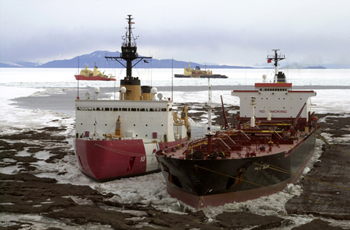|

Report of the OPP OAC Subcommittee on U.S. Antarctic Program Resupply available

April 25, 2006
On 16 December 2005, the Report of the OPP OAC Subcommittee on U.S. Antarctic Program Resupply was modified to correct typographical errors.
The Office Advisory Committee (OAC) for Polar Programs met on 11 August 2005 to review and accept a study of resupply alternatives for the U.S. Antarctic Program. The study was conducted by a subcommittee established by the Advisory Committee. The subcommittee was directed to develop and analyze alternatives, resulting in recommendations to achieve effective long-term resupply capabilities.
The sub-committee examined a broad spectrum of earlier studies, research, professional opinions, and practical experiences to develop recommendations that would establish a future resupply paradigm focused on:
- Assurance: The ability to continue to operate USAP science given a one-year lapse in primary resupply capability
- Efficiency: The ability to sustain additional science and science support with existing levels of resource investments
- Agility: The ability to readily adapt to changes in mission-driven logistical needs and operating environment
- Environment: The ability to conduct science and science support in Antarctica with absolute minimum impact on the natural environment.
The major recommendations include:
- Develop a comprehensive systems approach to antarctic icebreaking to alleviate the single-point of failure inherent in the current mode, and to reduce operating, maintenance, and fuel costs.
- Construct a wheeled-aircraft capable runway at Amundsen-Scott South Pole Station to allow direct supply from off continent and more efficient resupply from McMurdo Station.
- Continue development of a ground-traverse capability to provide alternative resupply of South Pole Station, to support remote field site research, and to assist McMurdo resupply.
- Lean McMurdo functions and assets to reduce resource requirements and optimize its utility as a logistics hub and science support base.
- Examine commercial business models and heavy-lift capability to augment and extend military capabilities.
- Examine lighter-than-air technologies to provide greater heavy-lift flexibility and efficiencies in the future.
The final report can be downloaded at the following links:
Related web sites

The National Science Foundation (NSF) is an independent federal agency that
supports fundamental research and education across all fields of science and
engineering, with an annual budget of $6.06 billion. NSF funds reach all 50
states through grants to over 1,900 universities and institutions. Each year,
NSF receives about 45,000 competitive requests for funding, and makes over
11,500 new funding awards. NSF also awards over $400 million in
professional and service contracts yearly.
 Get News Updates by Email Get News Updates by Email
Useful NSF Web Sites:
NSF Home Page: http://www.nsf.gov
NSF News: http://www.nsf.gov/news/
For the News Media: http://www.nsf.gov/news/newsroom.jsp
Science and Engineering Statistics: http://www.nsf.gov/statistics/
Awards Searches: http://www.nsf.gov/awardsearch/
| 


